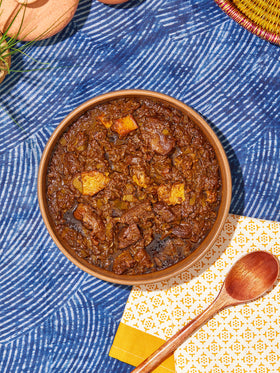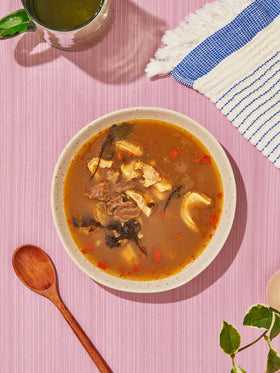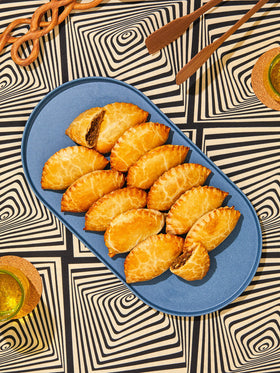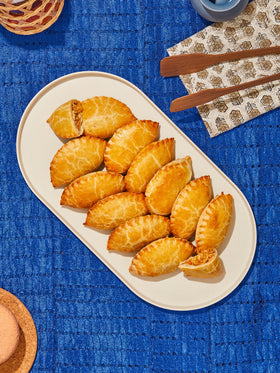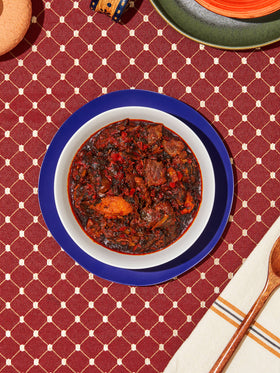Let's Talk West Nigerian Food and Flavors with Tobi!

Written by: Bethany
Tobi Smith is the founder of Adùn. His company makes African flavors accessible and gives everyone in the United States the option to get frozen, ready to eat African food shipped to their homes. He was born in Lagos, Nigeria, but with his father being a pastor, the family of four moved to Akure in Ondo state. Pastor Smith traveled all around Western Nigeria due to the nature of his work, and this gave young Tobi an opportunity to interact with a lot of traditional Yoruba foods within Ondo, Ekiti, Osun, and Ogun state.
From birthdays to weddings and even funerals, there was always one event or another that would present anyone with the opportunity to enjoy the range of dishes the culture has to offer.
Bethany Oyefeso: What types of food would you say one would find at a typical Yoruba ceremony?
Tobi Smith: For the most part, I’d say because of the generalist nature of “Nigerian Cuisine” we see the popular items. Part of the cuisine is the rice dishes like jollof rice, which everyone does, but then a lot more things are the soups and the sides where these things vary from state to state. Things that are enjoyed in Osun are kinda different from the ones that are eaten in Oyo state. Every state has its own flagship dish that it's noted for. There are popular Yoruba dishes, but when you go into these states and look at the various tribes and the different villages, you begin to know of the dishes that aren't super popular.
For a lot of people in Ekiti state, pounded yam is their thing. Pounded yam and Egusi is something they enjoy a lot. When you go to Oyo state, they do a lot of amala and gbegiri. That’s their thing in Ibadan, and some parts of Oyo will do lafun, which is the white version of amala. Places like Ilorin have fried wara, which is like a cheese curd. In Ondo, lots of pounded yam too, but then the side dish Asun originated from there. You can’t miss Asun at any function. The Ijebu people have something called Ikokore that’s made out of water yam and has a lot of seafood in it. It’s hearty and it’s warming. The crops that they grow and the products they bring to that part of the country influence these dishes. A lot of the palm oil is cultivated in Ondo state because they have lots of acres with oil palm trees, so they have a lot of palm oil in their foods.
Bethany Oyefeso: Nice. Wow. Listening to you list all those dishes makes me hungry. I’m glad I've gotten the chance to eat quite a number of the things that you've mentioned, and I know they taste absolutely delicious. Let’s take a soup like Egusi, do you know of the ways that the soup would vary from state to state?
Tobi Smith: For people that eat egusi a lot, you’ll know the first differentiating factor is the name. You hear things like Egusi Elefo that is egusi with vegetables or you hear Efo Elegusi, which is vegetables with egusi. I’d say where the vegetable is placed in the name of the dish determines what it has more of ratio wise. So just by looks, one has more egusi and the other has more greens. I think most of the time, it’s usually the same ingredients, the egusi, the crayfish, and the pepper. There’s almost always palm oil, but the techniques and ratio of ingredients are what determines where it is from.
Some will have no pepper mix at all, some will have roughly blended, some will be more fried, and others will have more meat stock. Same ingredients, different styles. Same with efo-riro. There's a generally accepted way, but some others will make it more watery or more dry. It changes from village to village and even from family to family. Same with a lot of other cuisines from across the world. We use the same ingredients but it’s made differently.
Bethany Oyefeso: Yes. Thank you for breaking that down. We see it all around the country, too. I know egusi is made by people from the eastern part of Nigeria also, and I’ve had egusi from my Igbo friend. It definitely tasted different than the yoruba style, which I'll probably attribute to their own traditional spices, and the consistency was a lot looser, which I loved. It was too sweet! I’m closer to Yoruba, but I really love a good bowl of egusi from the east.
Tobi Smith: Yeah. It always tastes really good. I’d say that’s one difference between the Easterners and the Westerners, they have more spices. More distinct spice flavor profiles that they add to their soups that make things taste different from what you taste in the west. You see things like okazi leaves or uziza seeds. It leads to a whole different experience.
We talked a bit more about me being slightly partial towards eastern nigeria egusi but quite frankly, it’s because of two things, I'm a girl that loves deep deep flavors and two, I love to have enough soup for my swallow. I’m the type to “lick” soup. Most of the Yoruba egusi that I’ve had so far tends to be on the dry side because it’s usually fried a bit more and it’s not unusual for it to be paired with some stew but the thing is the only soup I like putting stew on is boiled okro. I asked about some common ingredients that would be generally found across the board in western Nigerian cooking: Iru, palm oil, crayfish, and vegetables such as efo tete were mentioned. We moved on to talking about a traditional yoruba dish he’d introduce to someone trying the cuisine for the first time.
Tobi Smith: I would say pounded yam has to be the carb side 100%. It has to be yam that is actually pounded or put in a processor, either way works. For soup, it’ll be a tie between efo-riro and egusi because those soups are popular across the Yoruba part of Nigeria. They get half and half so they can enjoy both and see the differences. They’ll be covering a lot of ground. Later on, venture into other soups and swallows. Eba is also high up on the list, Ewedu, Gbegiri.
Bethany Oyefeso: Cool. Alright, so we shared what you would introduce others to now. What is your personal favorite?
Tobi Smith: That's a very tough question for me because I love a lot of foods, but honestly, I like to build my favorite food. Rice and stew with plantains or something with efo and plantains.
Bethany Oyefeso: pick one. The one dish that no matter your mood, that’s your dish.
Tobi Smith: Yeah, that dish is honestly pounded and egusi because I have a very fond memory of that dish but I was thinking about if i was to make a plate of foods that i like.
Bethany Oyefeso: okay, let me indulge you.
Tobi Smith: My dream plate would be rice with efo and plantains with really soft cow leg and goat meat that’s been in stew. That’s a perfect meal for me. There’s no name for a dish like this but it’s my perfect plate.
Bethany Oyefeso: Do you mind sharing the fond memory attached to your pounded yam and egusi?
Tobi Smith: Growing up, we went to a lot of church events with my dad. Now, the interesting part about church events is that the pastors usually ate their food from these events separately from everybody else. Most of the time, they ate first and in the back of the church or wherever it is. They would bring their own food in the ceramic Pyrex containers or the abo ajashe, which are those steel bowls painted white with flowers all around it.
One time, my dad called me into the room where everyone was eating and asked if I wanted to eat pounded yam. All the children were eating chicken and jollof rice by default but my dad requested that they give me a plate of pounded yam with egusi and goat meat and it was served wrapped in a leaf on a ceramic plate with the soup on the side and no child gets ceramic plates, you get your food in the styrofoam container. That moment made it so special, and of course, the egusi was stellar because the person who makes the best food in the church makes the food for the pastors. I vividly remember what the plate looked like, where I was seated, and I had a bottle of Maltonic by my side. Since that time, every time I eat pounded yam and egusi, I remember that moment, and I never wanted to eat jollof rice at events again.
We played a quick round of this or that before we wrapped up and I learned that if asun and peppered pomo were up against each other, he’s going for the pomo alata. Beans pottage wins over ikokore but when it’s between akara and ojojo, it’ll have to be ojojo fresh from the fire.
